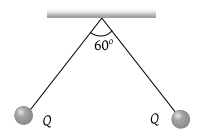An electron enters an electric field with its velocity in the direction of the electric lines of force. Then:
1.
the path of the electron will be a circle.
2.
the path of the electron will be a parabola.
3.
the velocity of the electron will decrease.
4.
the velocity of the electron will increase.
Two small spherical balls each carrying a charge Q = 10 μC (10 micro-coulomb) are suspended by two insulating threads of equal lengths 1m each, from a point fixed in the ceiling. It is found that in equilibrium threads are separated by an angle 60° between them, as shown in the figure. What is the tension in the threads (Given: )
(1) 18 N
(2) 1.8 N
(3) 0.18 N
(4) None of the above
An electron having charge \(e\) and mass \(m\) is moving in a uniform electric field \(E.\) Its acceleration will be:
1. \(\dfrac{e^2}{m}\)
2. \(\dfrac{E^2e}{m}\)
3. \(\dfrac{eE}{m}\)
4. \(\dfrac{mE}{e}\)
If an insulated non-conducting sphere of radius R has charge density ρ. The electric field at a distance r from the centre of sphere (r < R) will be
(1)
(2)
(3)
(4)
Infinite charges of magnitude q each are lying at x =1, 2, 4, 8... meter on X-axis. The value of the intensity of the electric field at point x = 0 due to these charges will be
(1) 12 × 109q N/C
(2) Zero
(3) 6 × 109q N/C
(4) 4 × 109q N/C
A pendulum bob of mass and carrying a charge is at rest in a horizontal uniform electric field of 20000 V/m. The tension in the thread of the pendulum is
(1)
(2)
(3)
(4)
A charged ball \(B\) hangs from a silk thread \(S,\) which makes an angle \(\theta\) with a large charged conducting sheet \(P,\) as shown in the figure. The surface charge density \(\sigma\) of the sheet is proportional to:

1. \(\sin\theta\)
2. \(\tan\theta\)
3. \(\cos\theta\)
4. \(\cot\theta\)
| 1. | \(8~\text{L}\) | 2. | \(4~\text{L}\) |
| 3. | \(2~\text{L}\) | 4. | \(\frac{\text{L}}{4}\) |
Three infinitely long charge sheets are placed as shown in the figure. The electric field at point P is
(1)
(2)
(3)
(4)
1. \(0~\text{V/m}\)
2. \(\frac{\sigma}{2\varepsilon_0}~\text{V/m}\)
3. \(\frac{\sigma}{\varepsilon_0}~\text{V/m}\)
4. \(\frac{2\sigma}{\varepsilon_0}~\text{V/m}\)








